When it rains in Uganda, plastic waste clogs street drains. For Faith Aweko, growing up in a slum in Kampala, the capital city, heavy downpours meant water flooding into the family home at the side of the road.
“During rainy seasons most of the roads here in Kampala are full of plastic bottles and bags because people dispose of plastic in trenches and gutters. This makes it hard for people like me in the slums,” says Aweko. Along with Shamim Naluyima and Rachel Mema, two women she met on a course on social innovation, she launched Reform Africa in 2018, turning plastic waste into waterproof bags.
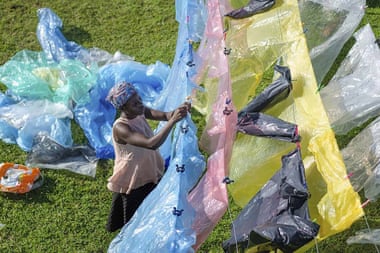
A team of women collect plastic bags and bottles from the streets and dumps. It is washed, dried and processed into a sustainable leather-like material to be made into backpacks, shopping bags and toiletry bags.
On average they make about 20 bags a day, which are sold in six boutiques across Uganda and on Reform Africa’s website, with prices ranging from $9 to $25 (£7 to £20). The venture has been a success.
Aweko says some of the backpacks are bought by humanitarian organisations and NGOs in Uganda.
“In the rural areas, you find that people cannot afford a decent schoolbag, so the parents buy plastic bags. But when the kids come home from school they are either torn or lost,” she says.
Sales initially fell in Uganda’s pandemic lockdown but bags are now being bought in the Netherlands, Germany, Britain and the US.
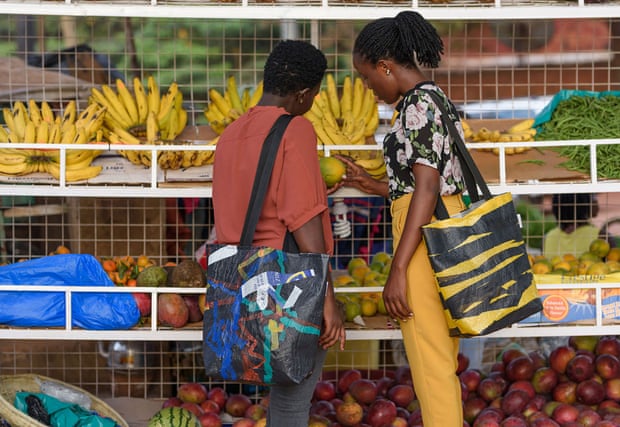
“We were actually able to double our sales from the previous year,” Aweko says.
Aweko is now setting up a factory to recycle hard plastics into items such as pegs and flowerpots, and she runs awareness programmes – key in a country where only 1% of waste material is recycled.
Tom Collins in Uganda
‘A shocking wake-up call’
It is break time at Mahim school in Mumbai and a group of children eat their snacks on benches made from recycled Tetra Pak cartons.
“This bench makes me happy, as it is made from waste,” says Aayush Khurana, 12, as she tucks into her food.
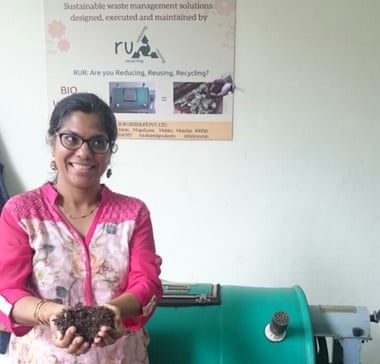
Mumbai produces more than 6,900 tonnes of waste a day and, in 2009, Monisha Narke began RUR Green life (Are You Reducing, Reusing and Recycling?) in response to the problem.
The social enterprise makes several products, but through its Cartons for Schools programme, it works with Tetra Pak India to turn plastic and paper cartons into benches, desks and chairs, which can be bought online and donated to government schools. The organisation, which also educates children about cutting back on plastics use, has recycled about 8m discarded cartons, and distributed more than 350 school desks and 250 benches.
Narke was inspired after visiting the Deonar rubbish dump – the largest in India. “Trekking up the piles of waste with our noses choked, watching the big green dump-trucks dotting the landfill was a shocking wake-up call,” she says. Discovering that Tetra Pak cartons contained paper, she wondered if something could be made out of them. “I learned that the cartons could be recycled to produce composite sheets. These sheets were used to make the seats in cars, and could be used in many other ways. That got me thinking about desks and benches.”
The cartons are now collected in three cities from shops, schools and colleges, with plans to expand.
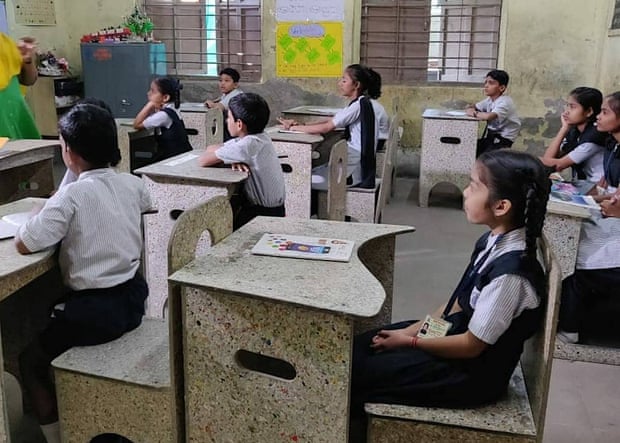
The cartons are shredded in factories, heated, compacted together and melted into moulds. About 4,500 cartons are needed to make a desk or chair, and about 6,500 for a bench.
“We had a great response to this initiative and hope to get more people involved,” says Narke.
Mohan Boghade, headteacher at Mahim school, says receiving the equipment brought great joy. “Having proper infrastructure aids students’ productivity and this move ensures every student has access to equal infrastructural standards.”
Kavitha Yarlagadda in India
‘This is something precious for us’
It took Ovy Sabrina and Novita Tan 18 months to develop the formula to turn plastic into bricks. The university friends wanted to do something about the 7.8m tonnes of plastic waste generated in Indonesia annually.
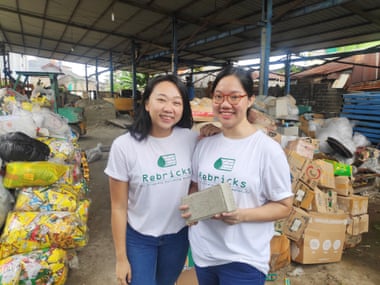
“If we really think about it, it is horrifying. There are still no solutions for many kinds of plastic waste,” says Sabrina. “Meanwhile, everything that we use now is made of plastic.”
The psychology graduates researched and ran trials to find the mix of cement and plastic that would be environmentally safe, durable and meet standards. In November 2019, they launched Rebricks.
“In the early days, we had to visit food stalls to ask for plastic waste because we didn’t have enough for production. Sometimes, the stall owners were suspicious and didn’t want to give the waste to us,” Sabrina says.
The company collects plastic sachets, bags, packaging and bubble wrap from three pickup points in Jakarta and one in Bandung, West Java. Some people even send them plastic through the post.
Nine employees recycle about 100kg of plastic a day. The company has recycled 17,500kg of waste and made about 100,000 bricks. It takes about 880 pieces of plastic to make one square metre of paving blocks.
The pair have received lots of support from the public. “It really warms my heart. Some of them sent us meatballs to eat. We feel very appreciated,” Sabrina says. “From morning to evening, our WhatsApp number kept receiving messages from so many people, asking about how they could send their waste to us.”
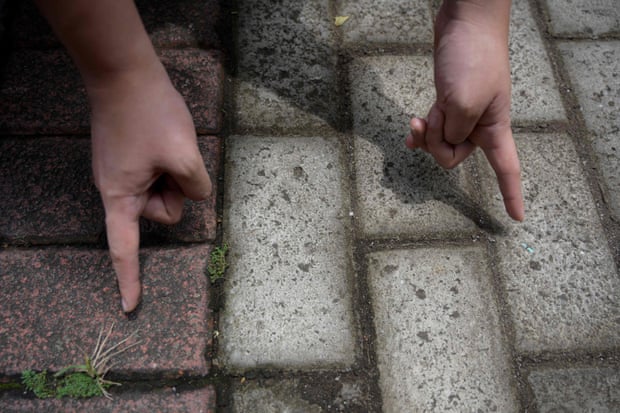
The women are planning recycling points in other provinces, so they don’t have to send waste between islands. They want to compete with conventional brick makers.
“For every square metre we think, OK, we have stopped this much plastic waste from being dumped at the landfill,” says Sabrina. “This is something precious for us.”
Gemma Holliani Cahya in Indonesia
‘An idea of producing artworks came to me’
It began with a rhino, but elephants, cheetah and pangolins now appear in Chisomo Lifa’s plastic artwork. The 27-year-old from Blantyre, Malawi, began collecting plastic waste two years ago, disheartened by the amount he saw on the city streets. “I didn’t really have an idea exactly what I wanted to do, but then the idea of producing artworks came to me.”
Lifa melts down bottles and bags and moulds them into animals, which he paints and varnishes. “The response from people was overwhelming and that encouraged me to continue with the idea,” says Lifa.

“I chose animals in my sculptures because there is also the problem of wildlife poaching,” he says.
His sculptures have been displayed at the Four Seasons garden centre, a leading art space in Lilongwe. He has also sold some of his work.
Lifa hopes that by turning waste paper and plastic into eye-catching art, he can start to sway people’s perspective on the environment and wildlife.
Campaigners estimate that 75,000 tonnes of plastic is produced in Malawi each year, 80% of which cannot be recycled. Most of it ends up in landfill.
Although the government moved to ban the manufacture, distribution and use of thin plastics, court injunctions obtained by manufacturers, and insufficient monitoring, mean plastics still flood the market.
Lifa, who started drawing when he was in bed with malaria in 2014, now teaches in schools and has an ambition to open an art school in the city.

“Working with plastics is adventurous but challenging at the same time, since we work at high temperatures. But I am greatly motivated and am now working on lesser-known animals like pangolins so that people can know what these animals look like.”
Charles Pensulo in Malawi
‘People can grow healthy food for themselves’
By turning bottles into plant pots, a sprawling residential neighbourhood in Peru’s capital is tackling two problems – plastic waste and the lack of space to grow vegetables.
Cut a hole in the side of a bottle, hang it upside down and fill it with soil, says Chris Cortez, head of environmental projects in Santiago de Surco, a Lima district home to about 350,000 people.
The bottles are big enough to grow lettuce, spinach, chard or one beetroot, radish or carrot. Connected by bottle caps screwed on through holes in the base of another bottle, they can be strung one on top of the other, in rows of up to seven, and hung on a wall.
Cortez says his online classes teaching vertical horticulture took off during the Covid pandemic.
“The idea was to show people they could grow healthy food at home,” says Cortez, 25. Peru had the highest death rate per capita and one of the world’s strictest lockdowns. “It gave them something to do when they were cooped up, particularly elderly people, many of whom grew up in the countryside,” he adds.

More than 220,000 reused plastic bottles now hang on a 700-metre stretch of wall on the edge of Lima’s largest and oldest recycling plant in the Voces por el Clima (Voices for the Climate) ecological park.
With a plentiful supply of plastic bottles, Cortez has used every inch of wall space for the horticultural technique, which saves water and space.
Every few weeks, kilos of vegetables are harvested and donated to one of 24 soup kitchens, which provide cheap meals in the district’s neighbourhoods.
Gloria Perez, 59, who runs the soup kitchen association, says she gets a delivery every few months. “Whenever there’s a harvest we receive something,” she says.
Dan Collyns in Peru
‘All the banks rejected my idea’
On her Twitter page, Nzambi Matee describes herself as a dancer. But the 30-year-old scientist is winning plaudits as the social entrepreneur behind a project to recycle waste plastic in Kenya.
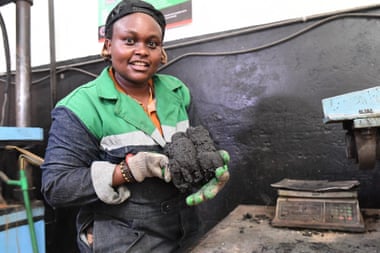
About 20% of the 2,400 tonnes of rubbish Nairobi churns out daily is single-use plastic. About 80% of it makes its way to Dandora, the city’s largest tip. Here, Matee saw an opportunity to turn some of the 500 tonnes of plastic into building materials.
In 2017, she gave her job as a data analyst and created a rudimentary workshop in her mother’s compound on the outskirts of Nairobi to learn how to make paving stones out of plastic. She had “a noisy machine”. “So noisy that neighbours gave me one year to wind down the operations or [they would] call authorities on me.” It took nine months – “a whole pregnancy period” – to make the first paving slab out of a combination of plastic and sand.
But while the founder of Gjenge Makers Ltd had passion, she didn’t have the capital to expand. She made several pitches to funders, “but all the banks I approached rejected my idea, saying it was too risky since I had no collateral. It was painful,” she says.
In 2018, Matee left for the US to raise funds, returning a year later with enough money for production. She now has a team of 113, many of them young people, who scour Dandora for plastic bottles and other containers.
By the end of June, Matee’s company will have recycled about 100 tonnes of plastic into 200,000 paving tiles.
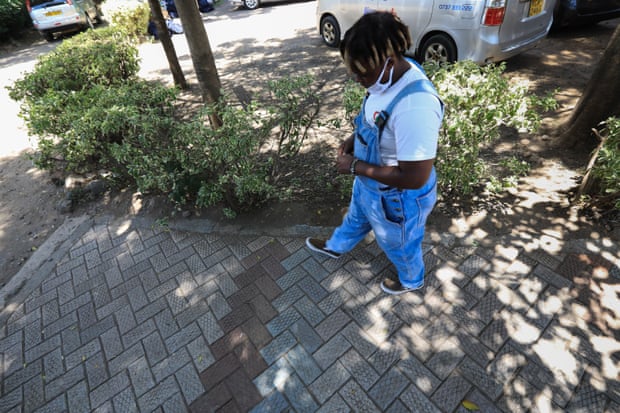
Matee is inspired by the late Kenyan environmentalist and Nobel peace prize winner Prof Wangari Maathai. “I want to have an environmental impact like Wangari Maathai,” says Matee, named as one of the UN Environment Programme’s 2020 Young Champions of the Earth. “Her main tool was activism, and I’m in science. I want to turn plastic waste into something useful. It’s a daunting task.”
Peter Muiruri in Kenya
Sign up for a different view with our Global Dispatch newsletter – a roundup of our top stories from around the world, recommended reads, and thoughts from our team on key development and human rights issues, delivered to your inbox every two weeks:
Sign up for Global Dispatch – please check your spam folder for the confirmation email